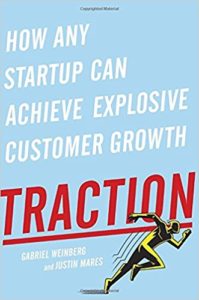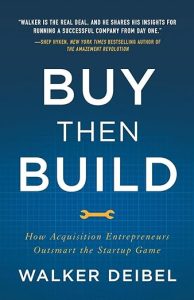I recommend this book to anyone who is trying to launch a product or service.
The reason I found this book so useful was that it leverages other founders’ credibility right off the bat.
Often times a book is published and the founder gives his insights into running a business but rarely uses outside influence.
From the start, this book interviews successful CEO and founders across a variety of different industries.
I love how each chapter is short, to the point, highly actionable, and has key takeaways at the end.
You can read through this book as almost a playlist. It is broken down into 19 traction channels. You could define 3-5 traction channels and work your way through them while recording the effectiveness of them.
It really is a great read and I highly recommend it. You can buy a copy here.
Summary of Traction: How Any Startup Can Achieve Explosive Customer Growth by Gabriel Weinberg and Justin Mares
Traction by Gabriel Weinberg and Justin Mares is a practical guide for startups and entrepreneurs that focuses on achieving growth by gaining “traction”—the measure of progress and momentum in acquiring customers. The book introduces the “Bullseye Framework,” which helps startups focus on the most effective marketing channels and avoid the common pitfall of spreading themselves too thin. Through a combination of strategies, case studies, and actionable tips, the authors present a systematic approach to acquiring customers and scaling a business.
Key Concepts:
- Traction is Everything:
The book emphasizes that no matter how good your product is, traction—gaining and retaining customers—is the key to success. Startups often fail not because they lack a good product, but because they fail to get enough customer attention. Weinberg and Mares argue that focusing on traction and testing different marketing channels is essential for growth. - The Bullseye Framework:
At the heart of the book is the Bullseye Framework, a process designed to help entrepreneurs discover the most effective marketing channels for their startup. The framework is divided into three concentric rings:- Outer Ring (Brainstorming): Brainstorm every possible marketing channel that might work for your business. This includes 19 channels the authors identify, such as SEO, social media ads, content marketing, email marketing, and offline events.
- Middle Ring (Testing): Narrow down the list to the top 6-12 channels that seem most promising and run small tests to gauge their potential. The goal is to quickly see which channels can generate early traction with minimal resources.
- Inner Ring (Focusing): Once you identify the most successful channel(s), focus on optimizing and scaling that channel to maximize growth.
- The 19 Traction Channels:
The book identifies 19 potential channels through which startups can acquire customers. These channels range from traditional to more innovative approaches, including:- Viral Marketing: Using customer referrals and word-of-mouth to drive growth.
- Public Relations: Getting media coverage and attention through press releases, interviews, and news stories.
- Unconventional PR: Staging stunts or creating content that gets attention and drives awareness.
- Search Engine Marketing (SEM): Using paid ads on search engines like Google to attract traffic.
- Social and Display Ads: Leveraging platforms like Facebook, Instagram, and Google to display ads targeting specific audiences.
- SEO: Optimizing content to rank higher in organic search engine results.
- Content Marketing: Creating valuable content (blogs, videos, infographics) that attracts, engages, and converts prospects.
- Email Marketing: Building an email list to communicate directly with customers.
- Community Building: Engaging with or creating a community around your product or niche.
- Business Development: Building partnerships with other businesses for mutual benefit.
- Sales: Directly selling your product to customers through outbound or inbound efforts.
- Affiliate Programs: Creating referral or affiliate systems where partners drive sales in exchange for commissions.
- Offline Events: Hosting or participating in events like conferences or trade shows to reach potential customers.
- The Importance of Testing:
Weinberg and Mares stress that one of the biggest mistakes startups make is failing to test and optimize their marketing strategies. By using small, low-cost tests, businesses can quickly identify which channels work best for them. The book encourages startups to iterate on tests quickly, continually optimizing their efforts based on the data they collect. - Focus on One Channel at a Time:
The authors argue that startups should focus on dominating one channel before moving on to others. By putting all their energy into a single successful channel, they can build momentum faster. This approach is about depth over breadth, maximizing returns on the best-performing channel rather than diluting efforts across multiple strategies. - When to Switch Channels:
The book also outlines when it might be time to switch channels. If a particular channel starts yielding diminishing returns or no longer scales efficiently, startups should return to the Bullseye Framework to identify the next most promising channel. Constant testing and adaptation are essential as channels evolve and audiences shift. - Traction and Product Development:
Weinberg and Mares emphasize the importance of balancing product development and traction-building efforts. Many startups focus exclusively on developing their product without dedicating enough time or resources to customer acquisition. The book encourages an iterative approach where product development and traction efforts happen simultaneously, ensuring a viable product reaches an audience. - Case Studies and Real-World Examples:
The book includes numerous case studies of successful startups that gained traction by focusing on specific channels. Companies like Airbnb, Dropbox, and Reddit are highlighted to show how they used unconventional PR, viral marketing, and content marketing to grow rapidly.
Conclusion:
Traction provides a practical roadmap for startups to systematically explore, test, and focus on the most effective customer acquisition strategies. The Bullseye Framework, combined with the 19 traction channels, offers a structured way for entrepreneurs to find the best way to grow their business. The book emphasizes the importance of experimentation, focus, and adaptability as key ingredients to achieving sustained traction and growth. It’s a must-read for any entrepreneur or marketer looking to scale a startup with measurable and repeatable growth strategies.
Join The Newsletter
Get occasional emails from me when I publish new projects and articles.



